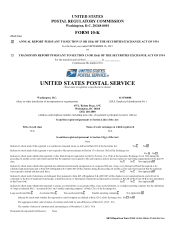US Postal Service 2015 Annual Report Download - page 9
Download and view the complete annual report
Please find page 9 of the 2015 US Postal Service annual report below. You can navigate through the pages in the report by either clicking on the pages listed below, or by using the keyword search tool below to find specific information within the annual report.2015 Report on Form 10-K United States Postal Service 7
Adverse events may call into question our reputation for quality and reliability or our ability to deliver the mail and could
diminish the value of our brand. This could adversely affect our revenue and results of operations.
Our brand represents quality and reliable service, and therefore is a valuable asset. We use our brand extensively in sales and
marketing initiatives and exercise care to defend and protect it. Any event, whether real or perceived, that calls into question
our long-term existence, our ability to deliver mail, our quality or our reliability could diminish the value of our brand and
reputation and could adversely affect our business operations and operating results.
The expiration of the exigent pricing surcharge will have an adverse impact on our future operating revenue and liquidity.
In December 2013, the PRC ruled that we could collect a 4.3% exigent surcharge on Market-Dominant services beginning in
January 2014, until such time as the exigent surcharge produces $3.2 billion in incremental revenue, or $2.8 billion in
contribution, a figure that the PRC determined was lost due to the Great Recession’s suppression of mail volume.
We appealed the PRC’s decision to the U.S. Court of Appeals for the District of Columbia Circuit (the “Court”), arguing that
the PRC attributed to the Great Recession far too little lost mail volume and that the exigent surcharge should remain in effect
indefinitely. In June 2015, the Court ruled on the appeal and remanded the case back to the PRC for further review, primarily
related to the PRC’s methodology for calculating mail volume lost due to the Great Recession. Although the Court largely
upheld the PRC’s analytical framework, it vacated one key aspect of the methodology for calculating mail volume lost due
to the Great Recession and suggested the PRC reconsider another element of its methodology.
On July 29, 2015, the PRC announced that it has authorized us to collect an additional $1.4 billion in revenue through the
existing exigent surcharge, which now may remain in effect until it produces $4.6 billion in incremental revenue. Because of
this extension, the exigent surcharge is expected to remain in place until approximately April 2016. We have appealed one
aspect of the PRC’s July 2015 decision, but that will not impact our ability to collect the additional $1.4 billion in revenue
authorized by the PRC. Absent a successful appeal, when the exigent surcharge expires, the prices of most Market-Dominant
services will decline, which will have an adverse impact on our future operating revenue and liquidity.
Our need to restructure our operations in response to declining mail volume may result in significant costs. It is possible
that the measures being considered would be insufficient to reduce our workforce and physical infrastructure to a level
commensurate with declining mail volume.
Our current network optimization plans include the consolidation of certain mail processing operations and reductions in
lobby hours of many retail units, post offices and other facilities. Presently, our regular review of the carrying value of our
assets has not resulted in significant impairment of our physical assets. However, future changes in business strategy, legislation,
government regulations or economic or market conditions may result in material impairment write-downs of our assets.
In the future we may also consider offering financial incentives to encourage employees to voluntarily end their employment,
as has been done in the past. Any impairment, incentives or other related costs we incur associated with such separations
would adversely impact our financial results in the short-term, although we would expect such actions to result in long-term
savings. In addition, we can provide no assurance that the mechanisms available under existing law and contractual
arrangements will be sufficient to reduce the workforce or facilities to a level that would allow a return to financial stability.
Our business and results of operations are significantly affected by competition from both competitors in the marketplace
as well as substitute products and channels provided by electronic communication services. If we do not compete effectively
and operate efficiently, grow marketing mail and package delivery services and increase revenue and contribution from
other sources, this adverse impact will become more substantial over time.
Our marketplace competitors primarily include providers of package delivery services. Our competitors have different cost
structures and fewer regulatory restrictions than we do and are able to offer differing services and pricing, which may hinder
our ability to remain competitive in these service areas. In addition, our competitors have access to public capital markets,
which allows them greater freedom in their investments and expansion of their business.
Customer usage of postal services continues to shift to substitute products and channels provided by electronic communication
services. Transactional mail, such as the presentment and payment of bills, has been eroded by competition from electronic
media, driven by some of our major commercial mailers which actively promote the use of online services. The volume of
our Periodicals service continues to decline as consumers increasingly use electronic media for news and information.
Periodical advertising has also experienced a decline as a result of the move to electronic media.






















